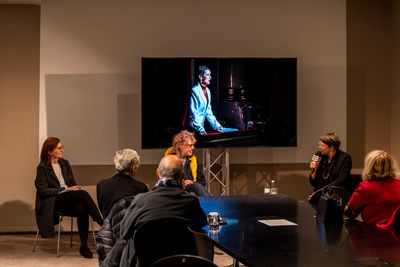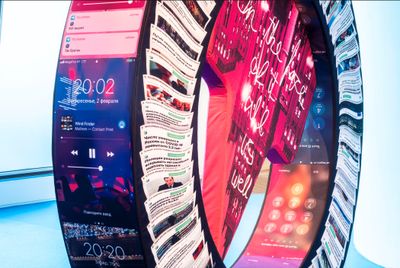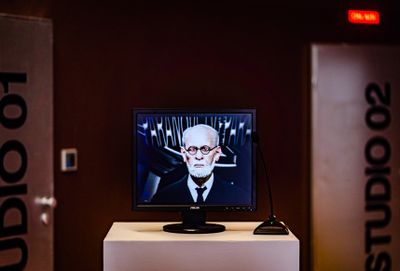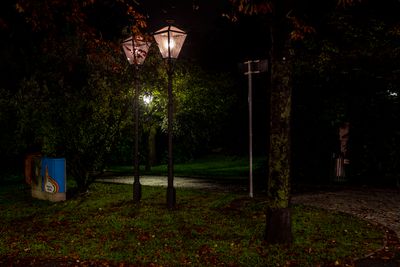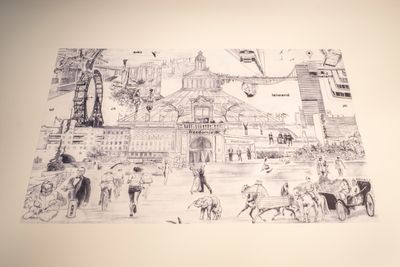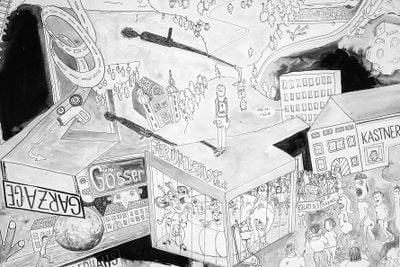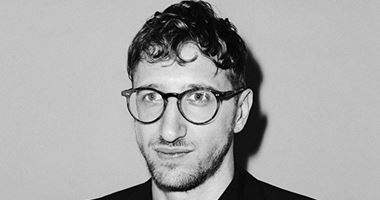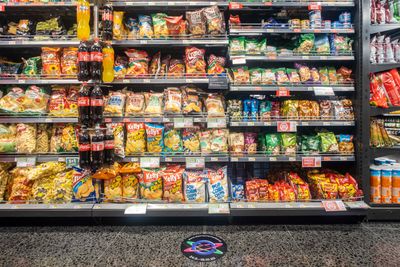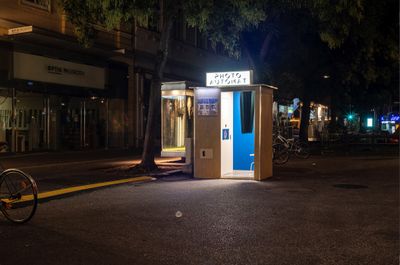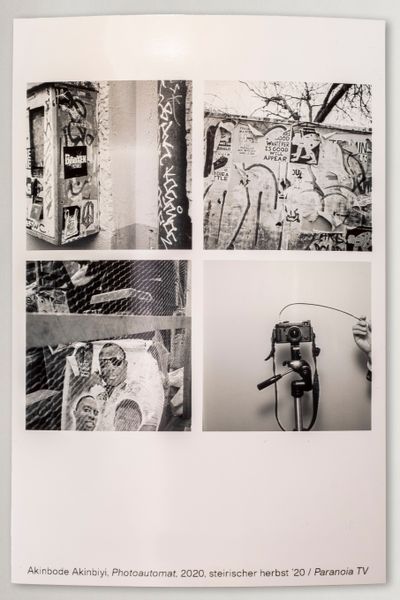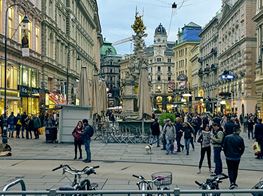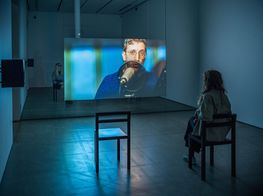steirischer herbst ’20: Becoming Paranoia TV
IN PARTNERSHIP WITH VEREIN K
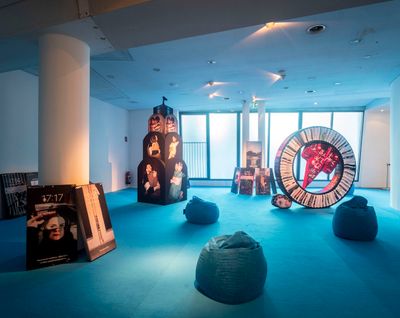
Igor Samolet, Cuddle Porn (2020). Exhibition view: steirischer herbst '20: Paranoia TV, Paranoia TV Headquarters, Graz (24 September–18 October 2020). Courtesy steirischer herbst. Photo: Mathias Völzke.
Led by director and chief curator Ekaterina Degot and her curatorial team for the third consecutive year, steirischer herbst '20: Paranoia TV (24 September–18 October 2020) is all about reinventing itself.
Looking to shift theme and format to accommodate the new scenario of Covid-19, the curatorial team devised 'a new form that actively responds to the current atmosphere of angst and uncertainty.' The result was a bespoke broadcasting platform 'for the uncanny and the unsettling' titled Paranoia TV, through which a majority of the programme unfolded—what Degot describes as 'Netflix but less lonely'.1
The Paranoia TV app is an impressive design, hosting over 30 hours of online programming with additional content being uploaded daily, including commissions by 38 artists and collectives like Ahmet Öğüt and Ingo Niermann, panel discussions such as Milo Rau in conversation with Achille Mbembe about 'The Paranoia of the Western Mind', an online game by Neil Beloufa & Bad Manner's titled Screen-Talk.com 1.9 (2020), and the literary festival, Out of Joint (6–9 October 2020).
The benefit of the online frame, despite the accrued fatigue around the overwhelming amount of digital content that the pandemic has unleashed, is the chance to spend time with commissioned audiovisual works.
Highlights include Lina Majdalanie & Rabih Mroué's Second Look (2020), a film in ten episodes that poetically looks at the relation of personal and collective memory within their own photographic archives collected in Berlin flea markets, and Rana Hamadeh's The Destiny Project / The Soft-Measure Fables (2020), a film in three episodes that remakes theatrically dramatic elements of Sophocles' Oedipus Rex tragedy into a virtual space accompanied by a deep and eerie soundtrack.
Works like these feel particularly relevant amid nationalistic Covidian times and steirischer herbst '20's theme of paranoia as a new 'problematic of our existence'. Dani Gal's triptych film Three Works for Piano (2020) connects the history of avant-garde music with testimonies by Israeli soldiers of their time in the West Bank and East Jerusalem, questioning the choice to remain silent or not and its significance within national narratives.
How Paranoia TV stands out is perhaps as an attempt at creating a platform integrating the online with real life. At the Paranoia TV Headquarters at Herrengasse 26, for instance, Igor Samolet's commissioned intervention Cuddle Porn (2020) refers to young people living in Moscow and the restrictions that came with the pandemic. The only escapism is the phone through which new affinities and political languages are developed and shared.
The installation includes giant soft mobile phone screens with text messages and personal photos from the artist and friends, where visitors can read private conversations and social media comments in relation to debauchery, 'hugging nostalgia', love, sex, drugs, Putin, and Trump. Visitors can also sit on bean bags and immerse themselves further in youth culture and use it as a relaxing space where most would also interact with their own phones.
The building itself was conceived as a fiction that comes with the broadcasting company imagined by the curatorial team, with the conference room taking on eighties aesthetics through the furniture selected. In one room, an interactive screen shows Sigmund Freud, father of psychoanalysis and mascot of Paranoia TV, answering queries that visitors might have about the future and its uncertainties with algorithmic responses based on his writings.
Within this frame, paranoia in the context of the contemporary art world could be diagnosed as a fear of not being up to date enough to address the trendy existential problems of the moment...
But while Degot stresses that steirischer herbst's intention is to find alternative ways of distribution and creating accessibility for a local audience, the selection of mostly international artists seems to contradict an emphasis on local relevance with Graz, a city that Degot describes as 'conservative liberal with a human face'. Knowing the hostility and exclusion that such politics produce, specifically for the most marginalised, Degot's statement was revealing: it brought attention to the limited frame of the 'local' that the festival seeks to engage with.
Though a small number of artists were commissioned to create installations and giveaway works around the city, including newspaper interventions by Sung Tieu—obituaries of lost and shifting terms in hand-drawn typography featured in the local newspaper Kleine Zeitung—there were moments of glaring contextual disconnection.
Dictionary of Imaginary Places (2020) by Vadim Fishkin, installed on the Burgring, a circular road surrounding Graz's Innere Stadt, consists of two lamps from which speakers sound out the names of 1,500 cities and places—imaginary places from literary references such as Homer and Tolkien taken from the 2001 book of the same name by Alberto Manguel and Gianni Guadalupi.
Unfortunately, the work poorly questioned the materiality of the imagination with a hard-to-hear audio that dissipated into the city soundscape, while simplistically exploring the idea of fantasy places in a context where mobility as a leisure is increasingly restricted. There was also a colossal lack of historical context with regard to the colonial narrative, within which the 'discovery' of 'tropic' and 'exotic' places is entrenched, not to mention the hostility towards migrant's rights when 'imagining' a new homeland.
The lack of relevance for marginalised voices, minorities, and potentially non-art audiences most affected by the pandemic—but with little visibility in the discourses enunciated in the programme—extends to attempts to respond to local access through six commissioned giveaways distributed across the city. These include two hand-drawn maps by Graz-based collective studio ASYNCHROME and Vienna-based Gelatin accessible at Moser, a local bookstore, and at Paranoia TV Headquarters.
In these efforts, no real community bridges were put in place to communicate outside the cultural centre—characteristic of a vicious cycle whereby the contemporary art world does not commit to speak beyond its own bubble as it performs the idea of engagement and 'diversity', all while asserting the pedantic assumption that art is for everyone.
The sound installation A Convention of Tiny Movements—SPAR Central Train Station (2020) by Lawrence Abu Hamdan is a case in point. Speakers hidden behind potato crisps bags and chocolate bars on the shelves of two local SPAR supermarkets—the supermarket being one of the most accessible public spaces in any urban community, even during lockdown—transmit a story of 'a not-too-distant future' in which new technology enables objects to play a Big Brother role. Still, supermarket staff seemed unaware of the installation's presence and content—it was as if the piece had been parachuted into their workplace.
Another parachuted work was The Final Match (2020), a radio play and performance by Janez Janša that unfolded on the official opening day with a two-hour taxi journey, during which a fictive football game was broadcasted on the radio. The scenario: the European Football Championship, postponed to 2021, is in fact happening in 2020. Two sportscasters animate the game with descriptions, anecdotes and theory in German, with English-speaking visitors provided with small tablets where they could follow the translation.
The performance was unsettling: not only for the two hours spent in an enclosed space during a pandemic, albeit with masks on, but because of the ethical implications of having 60 plus cars on the road, going in and out of Graz. (A statement on the exhibition website claims that CO2 emissions created during the show's run are being compensated through their calculation and evaluation with Climate Austria.) At the end, all the taxis gathered in a car park in a suburban neighbourhood, facing each other with loudspeakers blasting music, leaving local passers-by stunned.
Other efforts were more successful. For his participation, Akinbode Akinbiyi replicated the famous Berlin photoautomat with his interactive installation Photo Booth (2020), located in the middle of the Am Eisernen Tor square, a popular passage point in Graz is an interaction likely not to be missed by the locals.
For the cost of one euro, anyone can have their passport photo taken, with a twist—the result is a traditional four-block passport photo print including one self-portrait plus three photos that the automat randomly picks each time from Akinbiyi's photography archive of city landscapes from Bamako to São Paulo.
But even with such high notes, the festival did not seem to demonstrate a genuine relation to the city of Graz and its communities, with little visibility afforded to exhibitions staged by local arts organisations participating in steirischer herbst's parallel programme, despite direct relevance to the festival's themes.
Domestic Optimism, Act One: Modernism – A Lesbian Love Story by artist Emma Wolf-Haugh at the Grazer Kunstverein (24 September–20 November 2020), for instance, depicts 'mangled and mistold modernist legacies', while Image Wars. The Power of Images, curated by Jana Franze at Künstlerhaus, Halle für Kunst & Medien (4 July–8 October 2020), reflected on images and their relation to memory and trauma with video installations by Kader Attia, Cana Bilir-Meier, Melvin Moti, Rabih Mroué, Mario Pfeifer, and Marlies Pöschl.
Within this frame, paranoia in the context of the contemporary art world could be diagnosed as a fear of not being up to date enough to address the trendy existential problems of the moment, which results in issues being addressed halfway, without meaningful local engagement and with a lack of self-criticism.
Key questions that the festival raised is how the city of Graz has been affected by the pandemic and how well-funded organisations like biennials or city-wide festivals might become platforms for support and genuine participation in their own localities.
Furthermore, how do peripheral communities and those who do not have access to the arts become the centre in whatever form a contemporary art festival might take, not only in 2020 and within a pandemic, but beyond? These are interrogations worth considering with care and commitment.—[O]
I attended steirischer herbst '20 (24 September–18 October 2020) as part of a ten-day art critics residency with Verein K, a Vienna-based independent organisation with a focus on projects that critically engage with contemporary art and culture, co-founded in 2018 by artist Dejan Kaludjerović, creative practitioner Jelena Kaludjerović, and philosopher, art critic, and curator Klaus Speidel.
1 All quotes by Degot are taken from the steirischer herbst '20 press conference on 24 September 2020.


